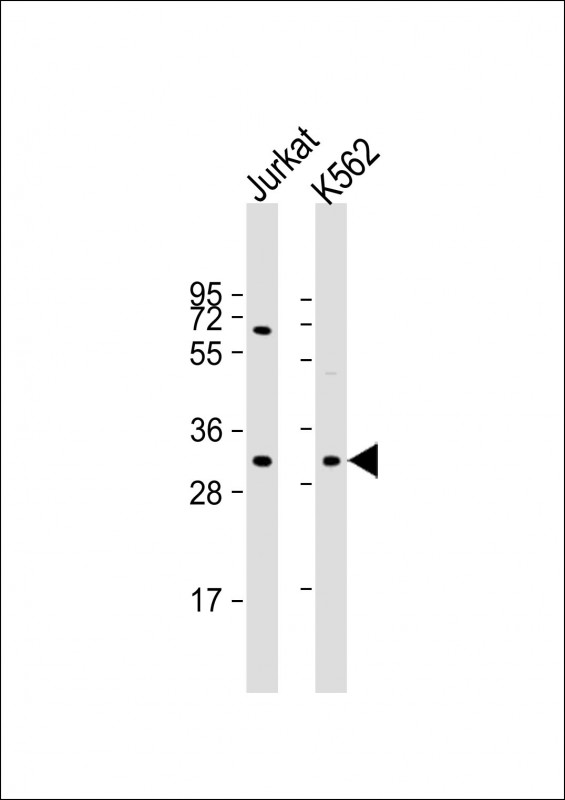TP53RK Antibody (C-term)
Affinity Purified Rabbit Polyclonal Antibody (Pab)
- SPECIFICATION
- CITATIONS: 1
- PROTOCOLS
- BACKGROUND

Application
| WB, E |
|---|---|
| Primary Accession | Q96S44 |
| Other Accession | Q99PW4, NP_291028.3 |
| Reactivity | Human |
| Predicted | Mouse |
| Host | Rabbit |
| Clonality | Polyclonal |
| Isotype | Rabbit IgG |
| Calculated MW | 28160 Da |
| Antigen Region | 221-250 aa |
| Gene ID | 112858 |
|---|---|
| Other Names | TP53-regulating kinase, Atypical serine/threonine protein kinase TP53RK, EKC/KEOPS complex subunit TP53RK, 36--, Nori-2, p53-related protein kinase, TP53RK, C20orf64, PRPK |
| Target/Specificity | This TP53RK antibody is generated from rabbits immunized with a KLH conjugated synthetic peptide between 221-250 amino acids from the C-terminal region of human TP53RK. |
| Dilution | WB~~1:1000 E~~Use at an assay dependent concentration. |
| Format | Purified polyclonal antibody supplied in PBS with 0.09% (W/V) sodium azide. This antibody is purified through a protein A column, followed by peptide affinity purification. |
| Storage | Maintain refrigerated at 2-8°C for up to 2 weeks. For long term storage store at -20°C in small aliquots to prevent freeze-thaw cycles. |
| Precautions | TP53RK Antibody (C-term) is for research use only and not for use in diagnostic or therapeutic procedures. |
| Name | TP53RK (HGNC:16197) |
|---|---|
| Function | Component of the EKC/KEOPS complex that is required for the formation of a threonylcarbamoyl group on adenosine at position 37 (t(6)A37) in tRNAs that read codons beginning with adenine (PubMed:22912744, PubMed:27903914). The complex is probably involved in the transfer of the threonylcarbamoyl moiety of threonylcarbamoyl-AMP (TC-AMP) to the N6 group of A37 (PubMed:22912744, PubMed:27903914). TP53RK has ATPase activity in the context of the EKC/KEOPS complex and likely plays a supporting role to the catalytic subunit OSGEP (By similarity). Atypical protein kinase that phosphorylates 'Ser-15' of p53/TP53 protein and may therefore participate in its activation (PubMed:11546806). |
| Cellular Location | Cytoplasm. Nucleus |
| Tissue Location | Highly expressed in testis. Weakly expressed in heart kidney and spleen. |

Provided below are standard protocols that you may find useful for product applications.
Background
Protein kinase that phosphorylates 'Ser-15' of p53/TP53 protein and may therefore participate in its activation.
References
Shimada, M., et al. Hum. Genet. 128(4):433-441(2010)
Facchin, S., et al. Cell. Mol. Life Sci. 64 (19-20), 2680-2689 (2007) :
Abe, Y., et al. Biochem. Biophys. Res. Commun. 344(1):377-385(2006)
Facchin, S., et al. FEBS Lett. 549 (1-3), 63-66 (2003) :
Miyoshi, A., et al. Biochem. Biophys. Res. Commun. 303(2):399-405(2003)
If you have used an Abcepta product and would like to share how it has performed, please click on the "Submit Review" button and provide the requested information. Our staff will examine and post your review and contact you if needed.
If you have any additional inquiries please email technical services at tech@abcepta.com.














 Foundational characteristics of cancer include proliferation, angiogenesis, migration, evasion of apoptosis, and cellular immortality. Find key markers for these cellular processes and antibodies to detect them.
Foundational characteristics of cancer include proliferation, angiogenesis, migration, evasion of apoptosis, and cellular immortality. Find key markers for these cellular processes and antibodies to detect them. The SUMOplot™ Analysis Program predicts and scores sumoylation sites in your protein. SUMOylation is a post-translational modification involved in various cellular processes, such as nuclear-cytosolic transport, transcriptional regulation, apoptosis, protein stability, response to stress, and progression through the cell cycle.
The SUMOplot™ Analysis Program predicts and scores sumoylation sites in your protein. SUMOylation is a post-translational modification involved in various cellular processes, such as nuclear-cytosolic transport, transcriptional regulation, apoptosis, protein stability, response to stress, and progression through the cell cycle. The Autophagy Receptor Motif Plotter predicts and scores autophagy receptor binding sites in your protein. Identifying proteins connected to this pathway is critical to understanding the role of autophagy in physiological as well as pathological processes such as development, differentiation, neurodegenerative diseases, stress, infection, and cancer.
The Autophagy Receptor Motif Plotter predicts and scores autophagy receptor binding sites in your protein. Identifying proteins connected to this pathway is critical to understanding the role of autophagy in physiological as well as pathological processes such as development, differentiation, neurodegenerative diseases, stress, infection, and cancer.


